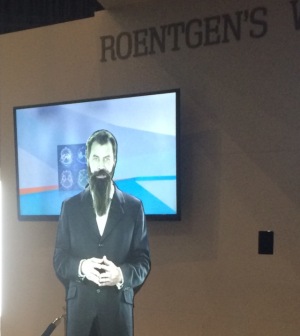Top 10 things you may have missed at RSNA
December 04, 2014

A hologram of Roentgen
greets his fans
By Gus Iversen, Lauren Dubinsky and Sean Ruck
With sore feet and pockets full of flash drives, the reporters at DOTmed News put their heads together and came up with ten stories of note from the floor at the 100th meeting of the RSNA. Here they are, in no particular order:
Dose tracking
With no Earth-shaking technology comparable to the emergence of CT or MR, the tech emphasis in recent years has been on improving the quality of the care patients are already receiving. Central to that conversation is responsible use of dose; a priority that ties in neatly with the industry's increasing momentum in the direction of big data and EHRs.
While the ultimate goals of transparency and accessibility are still little more than ideals, great breakthroughs from the OEMs, as well as companies like Unfors RaySafe and Viztek, are making it easier for physicians and patients alike to know how much radiation they have been exposed to, how little radiation is necessary for a given treatment, and how a patient's body chemistry may inform a radiologist's treatment plan.
Metal artifact reduction technology
Artifacts have always been a problem in X-ray imaging. A hip joint or a replacement knee may distort the picture and obscure the area being diagnosed. At RSNA 2014 we saw more companies than ever stepping forward with their own unique solutions to this problem. Some companies are employing new methods of obtaining the image and overruling the distortion in advance, while other companies have developed reconstructive tools to compensate for the noise caused by the metal.
As the population continues to grow older, the importance of imaging those particular areas is only being amplified. These metal implants are being built better and lasting longer, so health care professionals need to be able to look inside and see how the region surrounding the implanted device is developing.
RSNA retrospective
History was everywhere at the 100th anniversary of the RSNA. There was a room dedicated to old X-ray machines and back issues of the association's journal, as well as antique tubes and documents of historical significance. At the doorway to that display area was a lifelike hologram of the discoverer of X-ray, Wilhelm Roentgen. But for all those historical tributes, the show is nothing without the promise of the future.
In his opening address, Dr. N. Reed Dunnick, president of the RSNA, cited six keys to the future for radiology: developing the next generation of researchers, finding new ways to keep practicing radiologists up to speed on the latest techniques, funding those with great ideas, promoting partnerships across disciplines and within radiology, establishing far-reaching, smart public sector policies, and continuing to forge strong relationships with the imaging equipment industry.
|
|
|
You Must Be Logged In To Post A Comment
|
